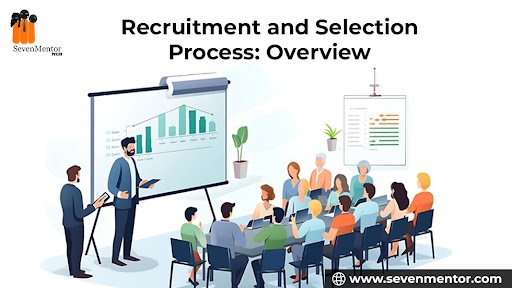Recruitment and Selection Process: Overview
In the realm of human resources, recruitment, and selection are pivotal processes that shape the composition and capabilities of an organization’s workforce. While the terms are often used interchangeably, they represent distinct stages in acquiring talent and ensuring the right fit for a given role. In this blog, we’ll delve into the disparities between the recruitment and selection process: overview, explore the steps involved in each process, and examine various methods employed to attract and choose suitable candidates.
Recruitment vs. Selection: Unveiling the Differences
Recruitment and selection are integral components of talent acquisition, yet they serve distinct purposes within the overarching hiring process.
Recruitment entails the initial phase of identifying and attracting potential candidates for job vacancies within an organization. It involves activities aimed at creating awareness about job opportunities, enticing qualified individuals to apply, and building a pipeline of prospective talent. Recruitment efforts typically focus on casting a wide net to reach a diverse pool of candidates through various channels such as job boards, social media platforms, career fairs, and employee referrals.
For Free Demo classes Call: 02071171727
Registration Link: Click Here!
On the other hand, selection is the subsequent phase wherein recruiters or hiring managers evaluate and choose the most suitable candidates from the applicant pool. This involves assessing candidates’ qualifications, skills, experiences, and cultural fit through interviews, assessments, and other evaluation methods. Selection aims to match the right person with the right role while aligning with organizational goals and values.
Step-by-Step Process of Recruitment
- Identifying Job Vacancy: The recruitment process commences with recognizing the need to fill a vacant position within the organization.
- Job Analysis: This step involves comprehensively defining the roles, responsibilities, qualifications, and attributes required for the position.
- Candidate Sourcing: Recruiters employ various methods such as job postings, social media outreach, networking, and talent databases to attract potential candidates.
- Screening and Shortlisting: Resumes and applications are reviewed to identify candidates who meet the minimum qualifications for the role.
- Initial Contact: Shortlisted candidates are contacted for further assessment, which may include phone screenings or initial interviews to gauge their suitability and interest in the position.
- Interviews: Qualified candidates undergo interviews, which may involve multiple rounds with different stakeholders to assess their skills, experiences, and fit for the role and the organization.
- Reference and Background Checks: Employers verify candidates’ credentials, and employment history, and conduct background checks to ensure the accuracy and reliability of the information provided.
- Job Offer: A formal job offer is extended to the selected candidate, outlining the terms and conditions of employment.
- Onboarding: The final stage involves integrating the newly hired employee into the organization through orientation, training, and familiarization with policies and procedures.
Step-by-Step Process of Selection
- Application Review: All received applications are screened to determine candidates who meet the minimum qualifications for the position.
- Shortlisting: Candidates who meet the initial criteria are shortlisted for further assessment.
- Assessment: Various methods such as interviews, aptitude tests, personality assessments, and job simulations are used to evaluate candidates’ suitability for the role.
- Interviews: Qualified candidates undergo in-depth interviews with hiring managers or panels to assess their skills, experiences, and cultural fit.
- Decision Making: Based on assessment outcomes, hiring managers make informed decisions regarding the most suitable candidate for the position.
- Offer and Negotiation: A job offer is extended to the selected candidate, including negotiation of terms such as salary, benefits, and start date.
- Notification: Candidates who were not selected are informed of the decision respectfully, providing feedback if possible.
- Onboarding: The selected candidate goes through the onboarding process to integrate into the organization effectively.
Various Methods of Recruitment and Selection.
For Free Demo classes Call: 02071171727
Registration Link: HR Training in Pune!
Recruitment Methods:
- Job Postings: Advertising job vacancies on company websites, job boards, and social media platforms.
- Employee Referrals: Encouraging current employees to refer qualified candidates for open positions.
- Recruitment Agencies: Outsourcing recruitment to specialized agencies that source and screen candidates on behalf of organizations.
- Campus Recruitment: Partnering with educational institutions to recruit graduates for entry-level positions.
- Networking Events: Attending industry events, conferences, and career fairs to connect with potential candidates.
Do visit our video on HR: Click Here
Selection Methods:
- Interviews: Conduct structured, behavioral, or panel interviews to assess candidates’ skills, experiences, and suitability for the role.
- Assessment Centers: Organizing assessment centers where candidates participate in various activities, role-plays, and simulations to demonstrate their abilities.
- Psychometric Tests: Administering tests to evaluate candidates’ cognitive abilities, personality traits, and aptitudes.
- Reference Checks: Contact candidates’ previous employers or references to gather insights into their performance, work ethic, and character.
- Background Checks: Verifying candidates’ employment history, education credentials, criminal records, and other relevant background information.
To summarize:
While recruitment practices on attracting and engaging potential candidates, selection involves evaluating and choosing the best-fit candidates for organizational roles. By understanding the nuances of these processes and employing appropriate methods, organizations can effectively acquire and retain top talent to drive their success and growth.
Author:-
Shashikant Phadtare
SevenMentor Pvt Ltd
Call the Trainer and Book your free demo Class for HR Training now!!!
© Copyright 2021 | SevenMentor Pvt Ltd.

